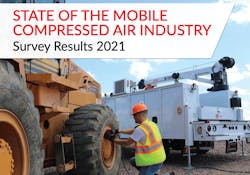VMAC surveyed 355 people for its State of the Mobile Compressed Air Industry Survey between November 2020 and February 2021. According to a report, the group surveyed a variety of professionals in the mobile compressed air industry, and found many survey participants shared similarities.
- Owners and operators/mechanics represent 71 percent of respondents, up from 55 percent last year.
- Construction industry was most represented at 42 percent of respondents. Responses also included transportation (21 percent), oil and gas (20 percent), forestry (18 percent). Utilities infrastructure was the industry with the lowest response at 15 percent.
- The majority of survey respondents use service trucks for equipment repair. The survey also asked respondents to describe applications their service truck is used for. General equipment repair was selected by 64 of respondents, while heavy equipment was chosen by 55 percent. The responses were followed by welding at 37 percent and tire service at 32 percent.
Service Vehicles & Fleets
When it comes to service vehicles and fleets, lighter truck class sizes and regular vehicle replacement are a priority, while the adaptation of hybrids and electrical vehicles in fleets is not. The industry continues to right-size its fleets, and most service vehicles are replaced every 3 to 9 years. Alternative fuels have a surprisingly low adoption rate.
- Most 2021 respondents indicated they have small fleets of 1 to 5 service trucks.
- Three-quarters (75 percent) of respondents have between 1 and 5 service trucks, up from 58 percent in last year’s survey.
- Only 9 percent indicated they have between 6 and 25 service trucks. Large fleets of over 100 trucks accounted for just over 4 percent of the reported fleet sizes.
- Over two-thirds of respondents (68 percent) indicated they have Class 2/3 trucks, while 41 percent indicated they have Class 4/5 trucks.
- As the truck classes increase, the number of respondents with these larger trucks decrease: only 23 percent of respondents have Class 6/7 trucks, and only 12 percent of respondents have Class 8 trucks.
- These 2021 results are nearly identical to the results in 2020, revealing that smaller trucks continue to be preferred.
Only 33 percent of respondents indicated there was at least one service van in their fleet, down from 55 percent in 2020. Most respondents (67 percent) revealed they have 0 service vans in their fleet.
Diesel and gas vehicles remain the most popular, with alternative fuel types losing popularity. When asked what kind of service vehicles survey respondents plan to purchase in the future, diesel was once again the clear choice, with 74 percent of respondents selecting this. Gasoline-powered vehicles were the second choice at 36 percent.
Electric vehicles and hybrids were the distant third and fourth choices. Only 9 percent of respondents selected electric, and only 4 percent selected hybrid.
Over half of all survey respondents (54 percent) stated they only require up to 59 CFM on their service vehicles. When including CFM ranges up to 99 CFM, this group grows to 82 percent of all respondents. Only 7 percent of respondents require CFM capabilities at 150 CFM or above.
Most respondents said they need 100 psi or higher on their service vehicles, with 87 percent of respondents choosing a range between 100 and 174 psi. The mid-range psi requirement of 120-149 psi was selected by 43 percent of survey respondents. Next, 24 percent chose 100-119 psi, while 20 percent selected 150-174 psi. Outliers were the 6 percent who require 90-99 psi, and the 7 percent who require more than 175 psi, on their service trucks.
Air Compressors & Equipment
When asked what percent of service vehicles have air compressors, the results were polarized. The largest group, 40 percent of respondents, stated that all their service vehicles are equipped with air compressors, while 30 percent of respondents selected less than 10 percent.
Two-thirds (65 percent) of survey respondents said their air compressor is the most important piece of equipment on their service truck. Next, 10 percent of respondents chose crane, 8 percent chose generator, and 6 percent chose welder.
Most survey respondents (80 percent) said they prefer rotary screw air compressors over reciprocating compressors for their service vehicles. In the previous year’s survey, only 67 percent of respondents preferred rotary screw. When asked to explain why they prefer rotary screw air compressors for their service vehicles, 75 percent of respondents noted performance, 38 percent noted quality and reliability, and 37 percent cited size and weight.
Nearly half of all respondents said they use above-deck gas engine driven air compressors. One in five (22 percent) respondents use UNDERHOOD or vehicle-engine driven compressors, while 16 percent use electric drive air compressors and hydraulic driven air compressors.
Over one third (35 percent) of respondents said that they prefer UNDERHOOD or vehicle-engine driven air compressors for their service truck. Next, 30 percent of respondents prefer above-deck gas driven air compressors, 23 percent prefer diesel driven air compressors, and 19 percent. prefer underdeck PTO air compressors.




